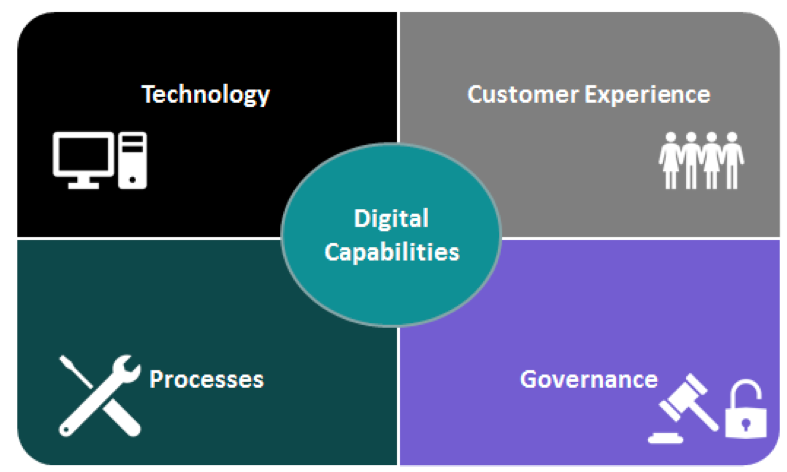by Business Analysis (BAPL)
As we enter the fifth industrial revolution, we can see that the product and services are transforming rapidly. The speed, breadth and depth of this revolution are forcing enterprises to rethink how products develop and how organisations create value. Sensing the need, many organisations are moving to adopt the new ways i.e. digitisation. Most of organisations need to re-invent their business and operating models in pursuit of digitisation to stay relevant and competitive.
A Business Analyst is looked upon to facilitate and manage this digital transformation journey. Being a conduit between business and technology stakeholders, a BA’s role is significant to achieving success in digital transformation projects. This blog identifies 7 key habits of a digital BA practice which are necessary to achieve success in the digital context.
1. Business Goal Centric
Business goals are strategic imperatives that the organisation is looking to achieve. Business goals map to the organisation’s needs (opportunity or problem). A digital business analyst creates and promotes a shared understanding of the business vision/goals and outcomes expected from the digital initiative. All the analysis effort is directed towards achieving the defined business goals, shunning noise. Business acumen is shown when constantly inspecting and refining these goals after considering new information, market changes and values.
A digital Business Analyst flags the conflicting goals and works with stakeholders to create consistency. Additionally, digital analyst works with stakeholders to set realistic timelines for achieving these goals.
2. Customer Empathy (Voice of Customer)
The digital market is changing rapidly, customer needs evolve, their liking and disliking changes continuously. Understanding the customer needs has become a matter of survival for organisations. The sole purpose of the digital initiative is to align with the customer experience and improve customer journey (internal or external customer). A digital business analyst helps organisations in the timely and correct interpretation of the user needs, wants and expectations using data to produce better outcomes.
A digital business analyst thinks as a customer and during the digital initiative ensures that all digital processes, technology and governance will result in better user experience. As digital initiatives often involve complexity, maintaining the focus on customer is a necessity for a digital BA.
3. Process Optimisation
The real opportunity in digital initiative is to look beyond technology and optimise processes in a way to positively impact the organisation. Digital transformations create processes which are more inclusive, human-centred and futuristic. The focus of digital initiative is to uplift or improve processes so that the “inside-out” strategy is challenged. Since the customer has become the centre piece for all the activities in a digital initiative, a digital Business Analyst constantly assess the process orientation towards the “outside-in” approach.
Technology is only a contributing factor in a Digital Transformation. The business analyst works with stakeholders and cross-functional teams to create processes which are leveraged to realise the complete potential for technology.

Figure 1: Organisation’s Digital Capabilities
4. Advocating an Agile Mindset
Around 70% of IT projects are delivered using Agile approaches. Additionally, Agile has found its application beyond the software development as Agility is now being adopted at the culture, communication, operational and delivery level. A digital Business Analyst is an Agile Advocate; they see the opportunity in,
- People and interaction over processes and tools
- Working “technology” over comprehensive documentation
- Customer collaboration over contract negotiation
- Responding to change over following a plan.
A digital Business Analyst challenges the status-quo, avoids waste, focuses on the high priority items first and delivers iteratively and incrementally. Transformations are complex and digital transformations even tougher. An Agile Business Analyst will always break the work into small, manageable pieces and deliver value rapidly and consistently. This Agility allows change which is easy to manage and control.
Feedback is sought at the delivery of each digital initiative’s stage. This feedback is fed into next iteration for improvement. A digital Business Analyst always facilitates resource allocation to high value analysis work first and is open to ideas with a focus on causes rather than output. These activities create a collaborative and Agile culture which helps technology to support the enterprise’s operation seamlessly.
5. Influence with Data
According to IBM, 90% of data has been created in the last 2 years and this ‘data overload’ is not going to stop as digitisation becomes the norm, and the Internet of Things integrates with our lives. Loads of data is available, getting to the ‘correct information’ is the challenge.
Six characteristics of good information are1:
- Clear (Precise and unambiguous)
- Relevant (appropriate to the concern)
- Economical (available at reasonable cost)
- Adequate (provides sufficient basis for assessment)
- Quantifiable (can be independently validated)
- Trustworthy and Credible
For digital initiatives, the Business Analyst needs to be a ‘power user’ than a data scientist. A digital Business Analyst works with Data Scientists/Data Analysts to get the ‘correct and relevant’ data and transforms it for meaningful presentation for stakeholders. A digital BA always considers the business context in the use of data and ignores the non-contextual information as ‘data pollution’.
A digital BA considers which source of data is more viable and reliable and interrogates the data to find rules and requirements to assist in developing digital solutions.
The presentation of data to influence the digital transformation path is managed by understanding the communication needs of stakeholders e.g. some stakeholders may be more data centric than others. A digital BA considers all these constraints to visually present data suitable to different the communication needs of stakeholders, which aids in creating the shared understanding of value.
6. Understand Technology and Governance
A digital business analyst adapts to technology trends and understands how technology solutions map to the business needs. Understanding the of technology helps a digital BA in the analysis work on:
- Security and access management
- Integration of Platforms (current or future)
- Future proofing
- Information Flow &
- Business Architecture
Cyber security is coming into the public eye (e.g. 5G) and a digital BA usually works under strict privacy and/or legislative regulations. Governance of a digital initiative is critical for an enterprise to operate in the presence of regulators and government scrutiny. Developing a consistent and up-to-date governance structure helps a digital BA in the analysis work on:
- Service Quality
- Privacy Regulations
- Information Management
- Content Optimisation
- Compliance and Licensing
- Legislative changes
A governance mechanism in digital organisations will save them from penalties and increase user trust.
7. Collaboration and Communication

As per McKinsey, the success rate for digital transformations was less than 30% in 2018. An organisation transforms for the stakeholders, customers (internal/external) and market factors. If collaboration is not achieved right from start, the moving pieces of a digital transformation make it challenging to achieve synchronisation.
A digital BA makes collaboration with all relevant stakeholders a key task in digital initiatives. A Digital BA uses their soft skills to facilitate cross-functional teams to collaborate.
A digital BA ensures bi-directional communication and that stakeholders are involved throughout as per their impact level. A digital BA is trustworthy and transparent. A collaborative environment will result in involved stakeholders, free flow of information and innovation.
References:
1 IIBA’s BABOK v3.0
